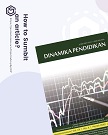Learning Community and Its Impact on Attitude toward Computer-Based Statistics
(1) Universitas Negeri Medan
(2) Universitas Negeri Medan
(3) Universitas Negeri Medan
Abstract
This study examined the three dimensions that should exist in a learning community, namely Student Cohesiveness, Integration, and Task Orientation, related to their influence on attitude toward computer-based statistics. Attitude toward computer-based statistics itself is measured using constructs of the revised Technology Acceptance Model (TAM). This study was designed to justify the value of information systems (IS) in overcoming accounting students' statistical problems. The use of IS probable to reduce the pressure in dealing with statistics so that there is an opportunity to increase accounting students' competitive advantage. The respondents consisted of 105 undergraduate accounting students. The data was collected using a 5-scale Likert questionnaire then analyzed using Structural Equational Modelling (SEM). With purposive sampling, this study was collected 105 responses obtained from private and state universities. The results indicate that task orientation is the key indicator of the learning community, affecting attitude toward computer-based statistics. Meanwhile, the second-order factors show that all three predictors were essential in explaining attitude toward computer-based statistics and significantly impacted Reuse Intention. This study also suggests implementing an informal learning community to build learning dynamics that are more independent but still controllable so that the learning topic is integrated with certain subjects.
Keywords
Full Text:
PDFReferences
Ajzen, I. (1991). The Theory of Planned Behavior Organizational Behavior and Human Decision Processes. Organizational Behavior and Human Decision Processes, 50(2), 179–211.
Ajzen, I., & others. (1991). The theory of planned behavior. Organizational Behavior and Human Decision Processes, 50(2), 179–211.
Cavanagh, P., Evans, J., Fiatarone, M., Hagberg, J., McAuley, E., & Startzell, J. (1998). Exercise and physical activity for older adults. Med Sci Sports Exerc, 30(6), 1–29.
Cooper, D. R., Schindler, P. S., & Sun, J. (2006). Business Research Method. McGraw-Hill.
Dalkir, K. (2013). Knowledge management in theory and practice. Routledge.
Davis, F. D. (1989). Perceived usefulness, perceived ease of use, and user acceptance of information technology. MIS Quarterly, 319–340.
Davis, F. D., Bagozzi, R. P., & Warshaw, P. R. (1989). User acceptance of computer technology: a comparison of two theoretical models. Management Science, 35(8), 982–1003.
Dorman, J. P., & Fraser, B. J. (2009). Psychosocial environment and affective outcomes in technology-rich classrooms: Testing a causal model. Social Psychology of Education, 12(1), 77.
Effiyanti, T., & Sagala, G. H. (2018). Technostress among teachers: a confirmation of its stressors and antecedent. International Journal of Education Economics and Development, 9(2), 134–148.
Fishbein, M., & Ajzen, I. (1977). Belief, attitude, intention, and behavior: An introduction to theory and research.
Fishbein, M., & Ajzen, I. (1981). Attitudes and voting behavior: An application of the theory of reasoned action. Progress in Applied Social Psychology, 1(1), 253–313.
Flood, B., & Wilson, R. M. S. (2008). An exploration of the learning approaches of prospective professional accountants in Ireland. Accounting Forum, 32(3), 225–239. https://doi.org/10.1016/j.accfor.2008.01.001
Fogarty, T. J., Zimmerman, A. B., & Richardson, V. J. (2016). What do we mean by accounting program quality? A decomposition of accounting faculty opinions. Journal of Accounting Education, 36, 16–42. https://doi.org/10.1016/j.jaccedu.2016.04.001
Fornell, C., & Larcker, D. F. (1981). Structural equation models with unobservable variables and measurement error: Algebra and statistics. Sage Publications Sage CA: Los Angeles, CA.
Fraser, B. J., & Walberg, H. J. (1991). Educational environments: evaluation, antecedents and consequences. Pergamon Press.
Fullan, M. G. (1993). Why teachers must become change agents. Educational Leadership, 50, 12.
Grimm, S. D., & Blazovich, J. L. (2016). Developing student competencies: An integrated approach to a financial statement analysis project. Journal of Accounting Education, 35, 69–101. https://doi.org/10.1016/j.jaccedu.2016.01.001
Hafsah, H., Sagala, G. H., & Ramdhansyah, R. (2018). Learning Community on Computer-Based Statistics Acceptance for Accounting Students. Dinamika Pendidikan, 13(2), 171–184.
Hair, J. F., Black, W. C., Babin, B. J., & Anderson, R. E. (2009). Multivariate Data Analysis 7th Edition Pearson Prentice Hall. JOUR.
Hasibuan, A., Sagala, G., Silaban, S., Simanjuntak, A., & Rahmah, A. (2020). Accounting Club and Its Impact on Academic Performance of Accounting Students. 1st Unimed International Conference on Economics Education and Social Science, 49–57. https://doi.org/10.5220/0009492300490057
Nguyen, T. H., Charity, I., & Robson, A. (2016). Students’ perceptions of computer-based learning environments, their attitude towards business statistics, and their academic achievement: implications from a UK university. Studies in Higher Education, 41(4), 734–755.
Nonaka, I., & Takeuchi, H. (1995). The knowledge-creating company: How Japanese companies create the dynamics of innovation. Oxford university press.
Onwuegbuzie, A. J. (2000). Statistics anxiety and the role of self-perceptions. The Journal of Educational Research, 93(5), 323–330.
Putri, R. S., & Wardoyo, C. (2017). The Development of Financial Accounting Learning Tools with Gall and Borg Model. Dinamika Pendidikan, 12(2), 86-97.
Rindskopf, D., & Rose, T. (1988). Some theory and applications of confirmatory second-order factor analysis. Multivariate Behavioral Research, 23(1), 51–67.
Sagala, G. H., & Sumiyana. (2020). The intersection of hedonic and utilitarian values on integrated-social media retailers. International Journal of Business Information Systems, 33(4), 505–530.
Sagala, G. H., Zainal, A., & Effiyanti, T. (2017). Attitude Toward Computer-Based Statistics Among Pre-Service Teacher Candidates. Proceedings of MAC, 366.
Sergiovanni, T. J. (1993). Frames of leadership. International Journal of Educational Reform, 2(1), 19–26.
Venkatesh, V., & Davis, F. D. (2000). A theoretical extension of the technology acceptance model: Four longitudinal field studies. Management Science, 46(2), 186–204.
Wang, Z., & Scheepers, H. (2012). Understanding the intrinsic motivations of user acceptance of hedonic information systems: towards a unified research model. Communications of the Association for Information Systems, 30(1), 17.
Wardoyo, C. (2016). Developing learning media based on e-learning on accounting subject for senior high school students. Dinamika Pendidikan, 11(2), 84-93.
Warwick, J., & Howard, A. (2016). Mathematical Anxiety as an Inhibitor of Skills Development in Accounting Students. Mathitudes, 1(1), 1–15.
Williams, M., Payne, G., Hodgkinson, L., & Poade, D. (2008). Does British sociology count? Sociology students’ attitudes toward quantitative methods. Sociology, 42(5), 1003–1021.
Wu, J., & Lu, X. (2013). Effects of extrinsic and intrinsic motivators on using utilitarian, hedonic, and dual-purposed information systems: A meta-analysis. Journal of the Association for Information Systems, 14(3), 1.
Refbacks
- There are currently no refbacks.

This work is licensed under a Creative Commons Attribution 4.0 International License.

.png)

.png)





